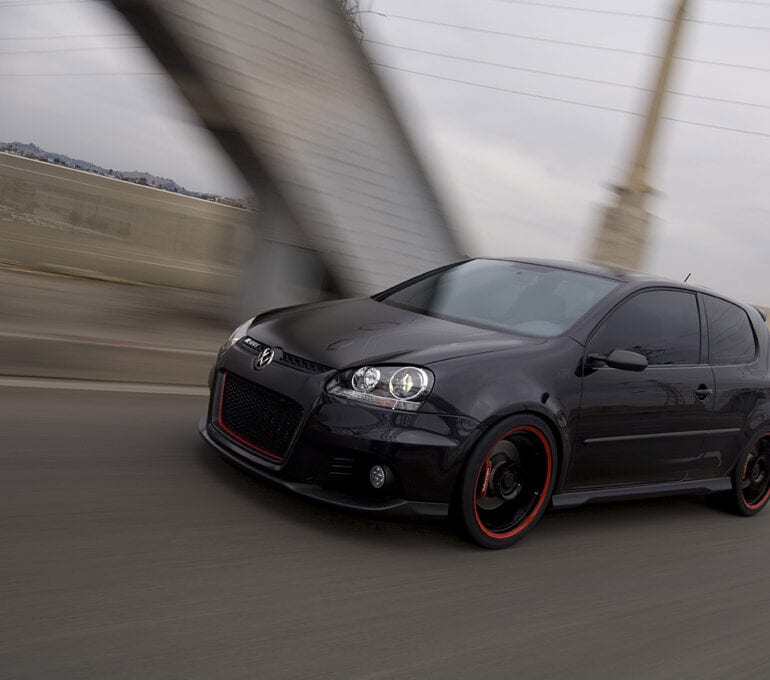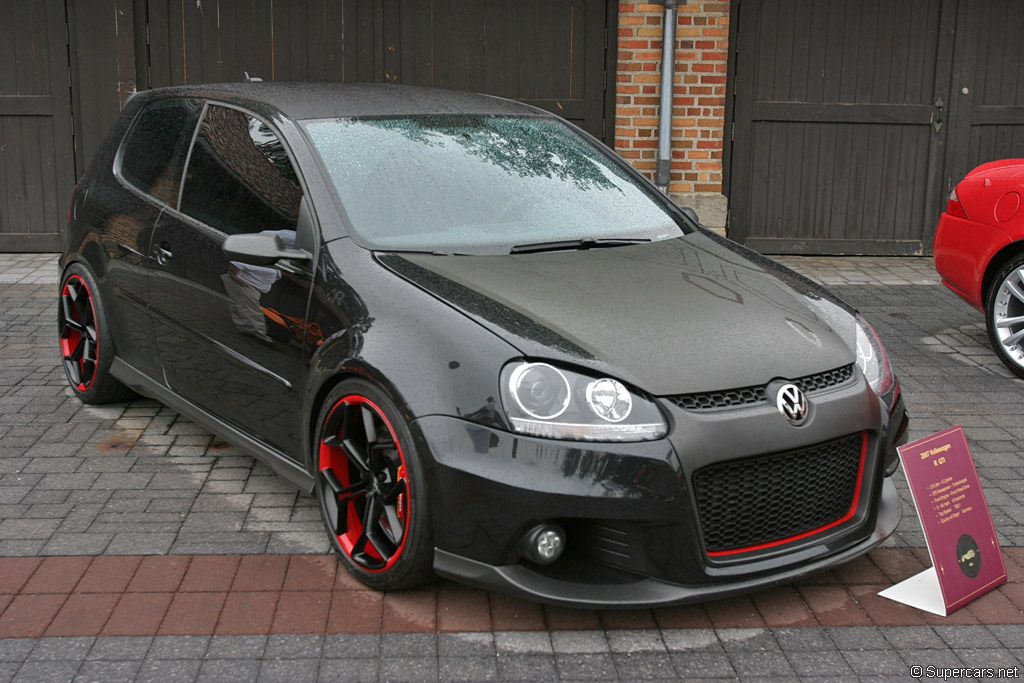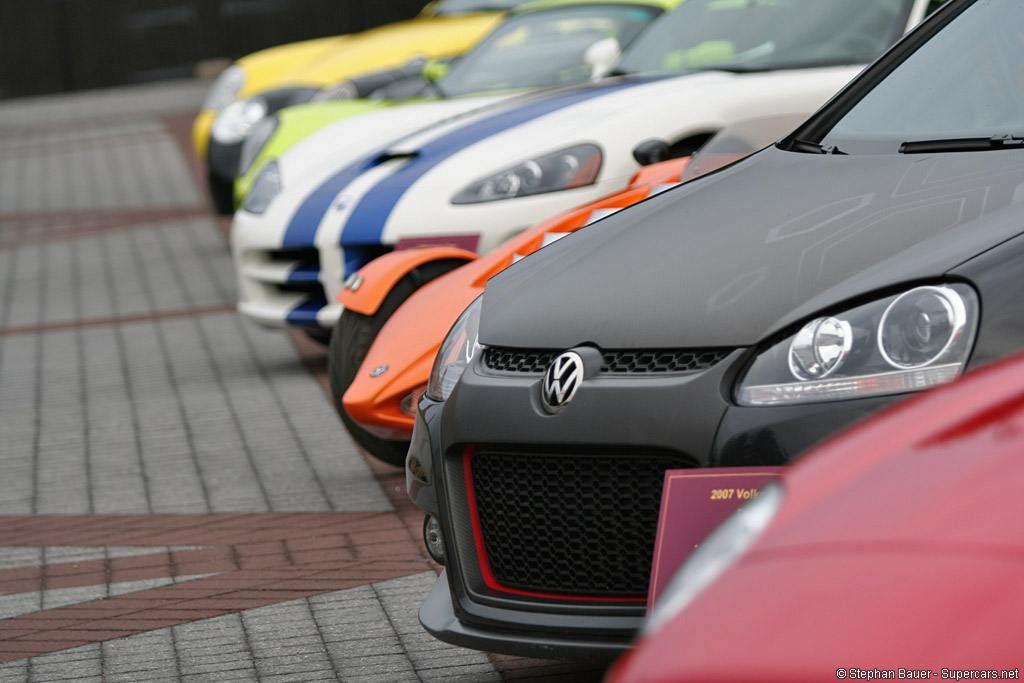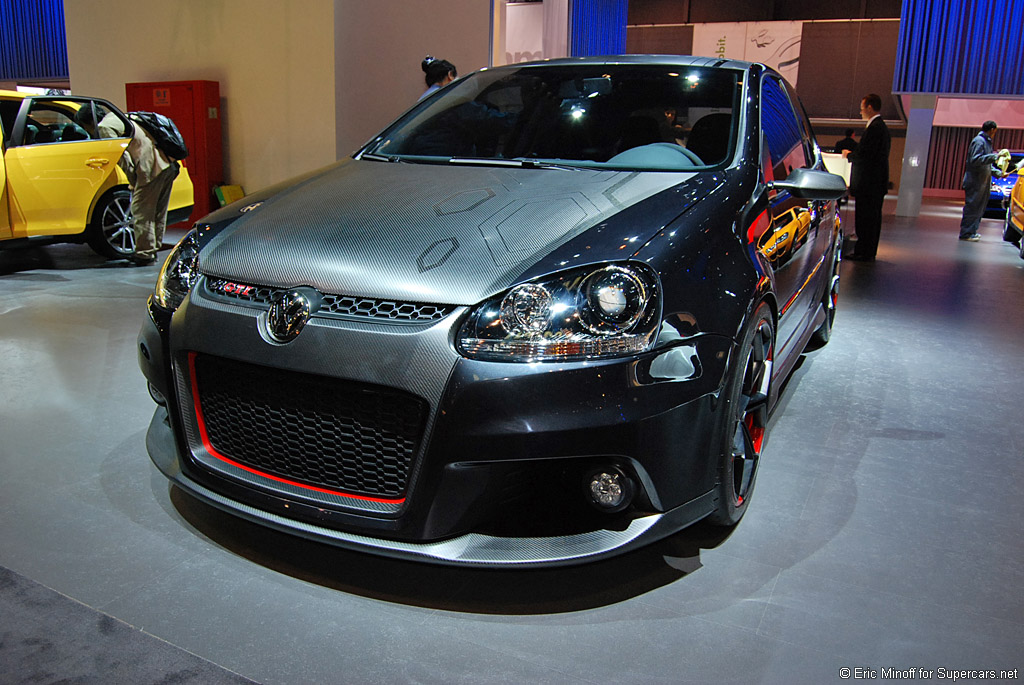2006 Volkswagen Golf R GTI
31 October 2006, Las Vegas-Volkswagen has cast an eye on the GTI of tomorrow with the R GTI, a low-flying stealth machine developed by Volkswagen Chief Designer Derek Jenkins and his talented crew at the Volkswagen Design Center California, located in Santa Monica. With its striking carbon-fiber body panels, four-passenger sports car interior, powerful turbocharged engine and competition-bred suspension, the R GTI is a stimulating fusion of style and dynamic excellence, fully modern in content and achievement yet staying true to such longstanding Volkswagen values as drivability, durability and utility.
The R GTI evolved from the stunning R Concept cars that stole the show at SEMA in 2005, and the R badge connects to the fabulous R32, one of the most sophisticated and thrilling Volkswagens ever to come from the factory. However, unlike those R concept vehicles from last year, which showcased the extremes of performance-tuned Volkswagens, the R GTI represents a more streetable concept. Although the R GTI is a one-off and Volkswagen currently has no plan to put it into production, the dedicated enthusiast could gather many of the R GTI’s elements for a personal project, sourced from Volkswagen or from the thriving automotive aftermarket that has helped keep the GTI?s red badge blazing in the hearts of the world’s driving enthusiasts.
Jenkins approached the R GTI with the motorsport-inspired goal of speed through lightness. That is, reducing the car’s weight is as critical to improved performance as amplifying the engine’s output. In collaboration with the firm OSIR Design, hand-laid carbon fiber component experts, Jenkins replaced the stock GTI’s front fenders, hood, side rockers, and hatch door with carbon-fiber panels developed by both OSIR and Jenkins’ in-house team. In addition to providing a weight advantage, the carbon fiber’s black weave creates a dazzling visual complement to the lustrous black paint scheme, which itself was adorned with hexagonal stealth graphics that echo the grille of the original GTI.
Additional carbon-fiber components are the lower front spoiler, front grille surround, rear rooftop spoiler and Jenkins-restyled rearview mirror housings, all in carbon fiber. Other distinctive exterior design touches include blacked-out front headlamp housings, R32 tail lamps with smoked lenses, R32-type central twin exhaust pipes with motorcycle-theme tips, a la Jenkins’ GX3 three-wheeler concept from 2005.
Reference to the GTI’s trademark hexagonal grille pattern is also seen in the R GTI’s specially constructed 19×9-inch aluminum alloy wheels, with lightness as a crucial contributor to reduced unsprung weight, and improved ride quality and cornering. Tucked within fenders designed for additional clearance, the beefier running gear includes Michelin Pilot Sport Cup ultra-high-performance radials, sized 265/30-19. In track tests, the larger tire footprint proved to be a valuable ally in transferring the engine’s prodigious 340 ft-lb of torque to the ground. Despite being rolled straight out of the design studio on to the track, the R GTI pulled off an impressive zero to 60-mph time of 4.8 seconds.
The chief contributor to the R GTI’s impressive performance is the turbocharged engine developed in conjunction with APR, one of the country’s leading aftermarket Volkswagen tuners. APR develops and sells high performance, and high performance only, leaving others to peddle air fresheners and floor mats. APR?s engineers and product developers are passionate about Volkswagen technology, and it shows in the quality and results of their contribution to the powertrain.
It all starts with Volkswagen’s 2.0-liter FSI turbocharged four-cylinder powerplant, an award-winner for its unique combination of direct injection and turbocharging. APR also replaced the turbocharger with a larger Garrett ball-bearing unit with twice the flow capacity and pumped up the boost to 21 pounds per square inch. All of the pressure-side plumbing was strengthened with silicon hose. A large-diameter cast-aluminum, black powder-coated intake pipe feeds the big turbo the cool air it needs from the larger, front-mounted intercooler, delivering twice the stock air flow. An Inconel exhaust manifold and an APR stainless steel exhaust system ensure efficient flow-through. It’s a tidy, factory-like transformation, and the result is a whopping 375 horsepower, on 93 octane pump gas. If 100-octane race fuel is used, output rises to some 400 horsepower.
Harnessing that kind of power is as important as unleashing it, of course, and Jenkins was determined to retain the stock GTI’s driver-friendly demeanor. The clutch was upgraded to handle the increased torque, and a Quaife limited slip differential was installed to make the engine’s power flow more efficiently through the tires. For the suspension Jenkins called on longtime experts H&R Tuning to supply a system that would be reasonably comfortable when the R GTI was used as daily transportation but would also deliver crisp, precise handling when the road gets twisty or for weekend track days. Replacing the stock suspension is H&R?s RSS Club Sport system of coil-over shocks and springs, augmented by a pair of adjustable sway bars. Ride height is reduced from 1.5 to 2.5 inches, but despite the ground-hugging stance and the Club Sport’s stiffer-than-stock settings, the suspension is compliant enough to comfortably dampen the rough spots in the road.
To bring deceleration into line with the improved acceleration, Jenkins selected Brembo brake components. Fitted at the front corners are Brembo’s four-piston aluminum alloy calipers, which squeeze Brembo two-piece floating cross-drilled discs with billet aluminum hats. The radial-mount design features a lightweight two-piece aluminum alloy body, quick-release pad system and sequentially sized pistons. The front calipers have even been painted with the colors of the German flag. Inside the rear wheels are disc brakes fitted with drilled rotors.
The exciting visual impact of the R GTI exterior is reflected in the interior, which is swathed in black leather complemented by red stitching. This theme runs throughout the cockpit, from the upholstery that covers the front Recaro Pole Position sports seats and rear custom-designed racing buckets, to the door panels and steering wheel, which also sports an R GTI logo. The effect is a blend of understated luxury and purposeful technology, underscored by the use of OSIR black carbon-fiber interior trim on the dash panel and in the doors.
Just aft of the front bucket seats is a clever safety belt system that was developed in the design studio. A remarkable example of the innovations that spring from Jenkins? creative team, it’s comprised of a bar that anchors the front racing harnesses, which can swing up and out of the way to allow passengers easier access to the two rear seats. As part of the R GTI’s weight-reduction program, the stock rear seats were removed and replaced by an exceptional piece of carbon-fiber craftsmanship. The single piece of composite was fashioned into two racing buckets, each fitted with padded leather inserts. They’re a snug fit but are comfortable enough to take the in-laws on a fast lap or two. Another trick interior element is the custom aluminum billet shift knob, which Jenkins fit with a red wheel that can be revolved by the driver’s thumb. Look closely, and you can see that the wheel has been inscribed with the R GTI logo.
The R GTI is an uncommon and visionary blend of design talent, factory technology and aftermarket innovation, and an enticing demonstration of why Volkswagen has been a favorite of automotive enthusiasts since the GTI first hit the scene 30 years ago. It also shows that the future of the hot hatch, as demonstrated by the R GTI, is already here.
In Detail
| engine | APR Tuned FSI Inline-4 |
| position | Front Transverse |
| aspiration | Garrett Turbocharger |
| valvetrain | DOHC, 4 Valves per Cyl |
| fuel feed | Direct Petrol Injection |
| displacement | 1984 cc / 121.1 in³ |
| bore | 82.5 mm / 3.25 in |
| stroke | 92.8 mm / 3.65 in |
| compression | 10.3:1 |
| power | 279.6 kw / 375 bhp |
| specific output | 189.01 bhp per litre |
| bhp/weight | 282.38 bhp per tonne |
| torque | 460.98 nm / 340 ft lbs |
| redline | 8000 |
| body / frame | Unit Steel w/Carbon Fiber Panels |
| driven wheels | FWD w/Quaife LSD |
| front tires | Michelin Pilot Sport Cup 265/30-19 |
| rear tires | Michelin Pilot Sport Cup 265/30-19 |
| front brakes | Brembro Discs w/4-Piston Calipers |
| f brake size | mm / in |
| rear brakes | Brembro Discs w/4-Piston Calipers |
| r brake size | mm / in |
| front wheels | F 48.3 x 22.9 cm / 19 x 9 in |
| rear wheels | R 48.3 x 22.9 cm / 19 x 9 in |
| steering | Electro-Mechanical servotronic steering with speed-dependent Pow |
| f suspension | MacPherson Struts w/H&R’s RSS Club Sport Coil Overs, Adj Sway Bars |
| r suspension | 4-Link w/H&R’s RSS Club Sport Coil Overs, Adj Sway Bars |
| wheelbase | 2578 mm / 101.5 in |
| front track | 1539 mm / 60.6 in |
| rear track | 1528 mm / 60.2 in |
| transmission | 6-Speed Manual |
| gear ratios | :1 |
| 0 – 60 mph | ~4.8 seconds |











